TOP TEN RELEASES OF 2007
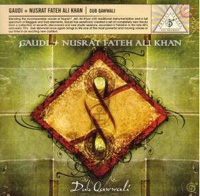
GAUDI + NUSRAT FATEH ALI KHAN
DUB QAWWALI (Six Degrees 657036 1137-2)
With Nusrat's sensational voice as the lead instrument, mixologist Gaudi has added a reggae feel to most of the ten tracks and plays the bass himself, in a fine rootical Flabba-Holt style. The secret ingredient here is the other genius on the set, this time a living one: Style Scott, drummer for the Roots Radics, Creation Rebel, and founder of Dub Syndicate. He worked with Adrian Sherwood at On-U Sound in London when he came on tour with Prince Far I in the 70s.
Now on the tenth anniversary of Nusrat's death, Gaudi has taken on the master of Sufi spiritualism, which is not too far from the "peace, love & unity" message of reggae. There is such solidity and consistency to this set you would swear the tunes had been written with Nusrat actively collaborating. Gaudi spent a year listening to unreleased tapes from the 70s, understanding the melodic structures and presumably thinking of where he could drop in some thundering dub in counterpoint to a slow passage, or coast out on a Stepper rhythm. Then he carefully removed most of the harmonium and handclaps from the original and started laying in synth, bass and drums. Style Scott was recorded at Channel One in Jamaica. There's a real string section and, as an added bonus, there are a few Asian instruments -- tabla, sarang, bamboo flute -- added to keep it rooted in the Sufi camp. "Dil da rog muka ja mahi" has a weird little synth riff from Kraftwerk, but it works, maybe because it too dates from the 70s when Nusrat was still unknown outside Pakistan. Indeed the overall warm sound of this album can be traced back forty years, because Gaudi used Hammond organ, Moog synthesizer, Fender Rhodes, and analog equipment including tape-loop reverb & echo units, tube amps, etc, that recall the sound of King Tubby, Lee Perry and other dub pioneers. This is Gaudi's twelfth album and Nusrat's 151st. It's stellar.
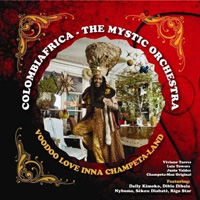
COLOMBIAFRICA - THE MYSTIC ORCHESTRA
VOODOO LOVE INNA CHAMPETA-LAND (World Network/Riverboat TUGCD1035)
Champeta is one of those great musical hybrids that was destined to happen. I think it was at a music festival in Barranquila in the mid-80s when Diblo jammed with Juan Luis Guerra that the idea took hold in a major way, but before that there were deejays in urban corners of Colombia spinning Fela & Prince Nico Mbarga albums and local drummers jamming along. Now the inevitable has happened: an actual collaboration where Congo meets Colombia in the studio. The impetus was the visit of Colombian producer Lucas Silva to Paris where he met soukous greats Dally Kimoko, Diblo Dibala, Rigo Star, Caien Madoka and Nyboma. He ran into Sekou "Diamond Fingers" Diabaté, founder of Bembeya Jazz, who sang him the opening of "Malanga," a Cuban song beloved by Colombians. Silva knew he had to pursue this collaboration, so he brought three singers from the town of San Basilio de Palenque -- Justo Valdez, Viviano Torres, and Luis Towers -- to Bogota and teamed up with Congolese composer/guitarist Bopol Mansiamina & Camerounian drummer Guy Bilong to put together the Mystic Orchestra. Then the African musicians were recorded in Paris. This is the best Congo-Caribbean infusion since Eddy Gustav's "Adans on surboum Isabelle." There's more touches of the sound system madness from the earlier Champeta albums but now the soukous part is much more apparent. The rhythms are mostly merengue, and the soukous guitar fits perfectly with the back-and-forth lyric sway and four square bomp of the kick drum. The liner notes also mention cumbia and bullerengue. The last track is a rootsy batata: a true Afro-Colombian groove. There's a cover version of Bopol's "Jaloux Jaloux," (a.k.a. "Pitié, Je veux la reconciliation") one of his most sublime hits, done in a sprightly uptempo salsa style with horns, Rigo on solo guitar and Nyboma singing. The Palenqueros' influences include Empire Bakuba, Soukous Stars, Soul Brothers from South Africa, and Coupé Cloué from Haiti and they manage to blend elements of all of them with great success into their sound.
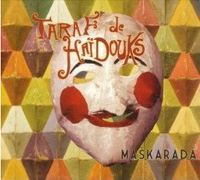
TARAF DE HAIDOUKS
MASKARADA (Crammed Disc CRAW40)
How can these guys continue to get better? They are already sensationally good at what they do: traditional Romanian gypsy music, and can throw it down with the best of them. Now they have upped the ante ... This is a great concept for an album, perfectly executed. You know how Dvorak, Prokofiev, Mussorgsky and then Bartok and Berg used to "adapt" folk sources for their music? And who did they hit the hardest? The underpaid, despised black folks of Europe, the Hungarian gypsies. So now it's payback time, the wild and witty band of gypsies from Clejani have torn up the sheet music and go for the guts of Bartok, Khachaturian, Manuel de Falla & Isaac Albéniz. The result is stunning, brilliant. The two most famous pieces, Albéniz' "Asturias" and "In a Persian Market," light classics from the pre-film era, are little mental movies, trips to Andalucia (where you don't have to queue all morning to see the Alhambra!) or Baghdad where there are fountains & princesses in disguise drawing water with the servant girls.
We kick off with a "Romanian dance" of Bartok from "Mikrokosmos" (1940) -- it's effortless, held together by Ionica on cymbalum. The clarinets handle the tempo shifts as if they were hiccups, the violins likewise toss it off without a second thought. Instead of "Sabre dance," they throw "Lezghinka" at us (from the same Khachaturian ballet "Gayaneh") & rip it up fiercely.
You know the De Falla piece (from "El amor brujo" of 1915), but it never had this kind of manic vamp, even after 100 heroines had been tied to 100 railroad tracks. The accordions stir as if a flea is getting to them then the great Viorel Vlad on double bass lays down the law. The chase is on to a flaming outro. Back to Khachaturian, and his famous waltz from"Masquerade." Come on, you surely know it. There you are, singing along. For me the centre-piece is Albert Ketelbey's "In a Persian market, " (1920) which was so popular, it was even covered by Tommy McCook. Where's my fez? The violins have a nice quarter tone dissonance making them a bit like Portsmouth Sinfonia, but also it brings you right back to the pit orchestra of the music hall, where much of this music was transmitted to our grandparents and great-grandparents' ears. I don't mind admitting I have the sheet music & play it myself! For the Taraf the centre-piece is probably the suite of Romanian folk dances by Bartok, the longest track on the album. Needless to say they take it all back. "Asturias" is a stormer, they rip into it, then sit back for the largo part. But then they go off into their own thing at the end. "Les portes de la nuit" by Kosma includes "Autumn Leaves" -- it's quite symphonic, but with a vengeance! The accordions float in and out in the mist but the cymbalom keeps creeping up on you (Look out!). As if all that were not enough there are 7 original compositions to remind us of the creative power of this band. It's a great selection, exquisitely performed and crisply recorded.
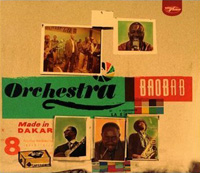
ORCHESTRA BAOBAB
MADE IN DAKAR (World Circuit WCD078)
Orchestra Baobab serves up 11 choice cuts of prime Senegalese soul. Originally they took griot songs and Latin covers and brought them into a modern Senegalese idiom, forging a unique sound, which has cantering rhythms, great harmonies, soaring vocals, exquisite filigree guitar leads and jazzy saxes, all in one sweet package. "Papa Ndiaye," the classic opener, was first heard on BAWOBAB 75 (though it had been in their repertoire since 1968). "Beni Baraale" is a cover of a Bembeya Jazz song, & goes back to the roots of Baobab when some of the members played in the Star Band de Dakar, and a memorable night in 1969 when they shared a bill with Bembeya. Assane Mboup, one of Youssou's protégés steps up for "Nijaay," a reworking of a song by Laye Mboup with a bustling arrangement by Attiso who can be heard off in the corner soloing madly. (In fact he even throws a bit of Bach's D minor Fugue at it!) "Ami kita bay" is also new to me, though it has the familiar Baobab ingredients, as mbalax and salsa meet on the dancefloor. "Cabral" (Homage to Guinean freedom fighter Amilcar Cabral), which uses the "Guantanamera" changes, is one of their most enduring songs. It has been anthologized thrice before: Günter Gretz put it on ROOTS & FRUIT (Popular African Music ADC304) in 1999; the Sheer Sound compilation in their African Classics series led off with it, and the Oriki Music disc "A Night at Club Baobab" also featured it. "Sibam," the busy number which follows it, was on the Sheer compilation, as well as ON VERRA CA, the World Circuit compilation that collected the 1978 Paris Sessions. Thirty years later it's hotter than ever, with sabar and tama drums kicking it up a notch. There's an added trumpet solo: it's great to hear more rather than less brass instruments in the mix. There are some new songs in the classic Baobab mode, but it's another oldie that scorches the speakers: "Ndéleng Ndéleng," by Thione Seck. (Seck left Baobab to form Le Raam Daan, a band he still fronts.) Assane Mboup delivers this, sounding a lot like Youssou. Thio Mbaye's sabar drums are busily driving the dancers then Attiso steps up for a magical, inventive solo where he demonstrates how he can run rings around any guitarist alive. (The earlier 7.5 minute version, sung by Seck, can be heard on AFRICAN CLASSICS but it is a thin recording. Here they retain the big room echo, but it is a much more dynamic recording.) "Bikowa," a calypso by Issa Cissoko is a gorgeous ballad, with a hunt of "Stormy Weather." Issa's alto playing is great. "Colette," the final cut, dedicated to Attiso's wife, is another slow swaying dance groove, with a hot trombone solo. Attiso teases little moans out of his ax, dedicating the song to Carlos Santana.
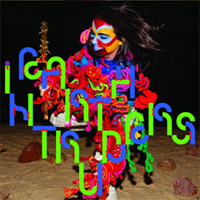
BJORK
EARTH INTRUDERS
"Earth Intruders" was the single from Bjork's album VOLTA. It was also released as an EP with four club mixes. If you buy the album on iTunes you can skip the duets with Anthony which are insufferably wet and the song about the Lady Suicide Bomber, and add the remixes to make a better album. For that matter you can also add in "Mama na bana" from Konono Number One's LIVE AT COULEUR CAFE to get the full effect as she is jamming with them, though their sound is buried in the Björk album. This is Björk's sixth album, and though she feels she has to reinvent herself completely each time, this is a return to a more primitive kind of punk (albeit with very slick sidemen), and makes for great get-up-and-get-down music. It's accessible, brassy, and above all rhythmically propulsive.

GYPSY CARAVAN
MUSIC FROM THE FILM WHEN THE ROAD BENDS (World Village 468070)
No doubt you've seen Tony Gatlif's great documentary LATCHO DROM. That film completely opened our eyes to the currents of music that wend from Rajasthan to Poland, and from Egypt to Spain. Through it we discovered Taraf de Haidouks and Hameed Khan's ensemble MUSAFIR. Then we got to see them on tour and suddenly a gypsy revival was in full swing. The latest wrinkle in the gypsy trail is a return to that bright moment captured by Gatlif: Jasmine Dellal, another documentarian (who worked with Marlon Riggs), has made her version of the gypsy tale and this is the soundtrack album, which bodes well for the enterprise, the film, and no doubt more tours.
Gypsies, as is well know, spend their lives on the road. The gypsy caravan used to be a very romantic notion and the lore of gypsies has engaged non-Roma since George Borrow, Cervantes, and even earlier writers. The title of the film was going to be YOU CANNOT WALK STRAIGHT WHEN THE ROAD BENDS... (a Romani proverb), but marketing forces got involved and it became GYPSY CARAVAN, which is a lot less inspired. Actually the true title reminds me of one of my favourite maxims, from Yogi Berra: "When you come to the fork in the road, take it!" Right from track two, when Fanfare Ciocarlia start playing live, you know this is going to be exceptionally good. Esma Redzepova, with her clear voice, delivers "Romano horo" (footage of her from 40 years ago when she was a teenager) and then after a bit of table percussion, bottle tapping, etc, and some spontaneity on accordion, we get into Taraf de Haidouks with Filip Simionov adding clarinet, doing "Carolina," now thoroughly Romanized, though of course it actually started out as the well-known Caribbean folksong, "O Carolina!" The film-maker explains she had over 50 hours of music on tape and it was an embarrassment of riches, so the film is just the bits that worked best, though there were uncaptured moments on tour -- in airports, customs detention rooms, hotel rooms after hours -- that were even more compelling, if you were there. The group called Maharajah from Rajasthan is actually a blend of the two well-known groups the Langa and the Manganyar (all are Muslim, and have the surname Khan). I recognize "Roomal" from their repertoire, but there is also an interesting dubby club mix of one of their tunes. There's an extended set of them on the CD then we get back to Esma Red Zep, now with Fanfare Ciocarlia (from the KINGS & QUEENS album) tearing through "Nakalavishe," and Taraf de Hijkinks doing their "slow" about the "Little Blossom," "Mugur Mugurel." The film was shot by legendary cinematographer Albert Maysles.
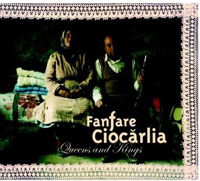
FANFARE CIOCARLIA
QUEENS & KINGS (Asphalt Tango ATR-1207)
Fanfare Ciocarlia is the top Romanian brass band. This, their fifth album, is a tribute to their leader clarinetist Ioan Ivancea, who died last year. The band travelled all over Europe, from Bulgaria to France, to jam with gypsies of the diaspora and add many nuances to their sound. To their funky Balkan brass beat they have added flamenco guitar and Macedonian accordion, as well as the pop sensibilities of homeboys KAL. Though these sounds are quite disparate they have been part of the musical heritage of all gypsies through centuries of musical exchange and more recently cassette tapes which have brought Latin, jazz and pop touches to their sound. So this is a showcase album, reminiscent of Tito Puente's 100th album (I almost said 100th anniversary) where he recorded and toured with Johnny Pacheco, Celia Cruz, and a host of luminaries; which was good in theory but not in practice as it was 3 a.m. by the time Celia came on.) The top pop singers, Dan Armeanca and Jony Iliev show up, as do Esma Redzepova, Mitsou, Ljiljana Butler and other gypsy singers, but it's the arrangements and horn solos I find engaging. Armeanca, who has sung with the band before, kicks things off with "Kan marau la," possibly the strongest track on here. The 11-piece orchestra is in top form, having absorbed old movie tunes, Turkish pop, and all the forgotten bits of musical history from "Blue Rondo a la Turk" to the Lamabada. Here is a whole cross-section of the best gypsy sounds around, presented in a rotating roster of styles. To crown the proceedings there's a farewell march in honour of Ivancea, and then a raucous outro rip-up of "Born to be Wild!" which was used appropriately in Sasha Baron-Cohen's sly satire BORAT.
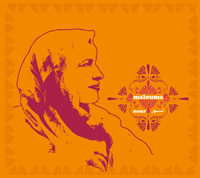
MALOUMA
NOUR (MARABI 46819 2)
She has been called, rather blithely, "The Blueswoman of the Desert," but Malouma is much more than that. She has struggled for female emancipation in her native Mauretania. Since her first album DUNIYA she has continued to improve. Malouma's third international release is called NOUR. You may not have heard of her or even noticed her, because her album packaging is so abysmal. In 1998, Shanachie issued DESERT OF EDEN, produced by Pape Dieng at Studio 2000 in Dakar. The session men included Oumar Sow on guitar and Thierno Kouyate on sax. The first track, "Ya Habibi," was anthologized on a box set (WORLD DIVAS, I think) and it was from there that British DJ Charlie Gillett gave it several plays. It resurfaced on a Shanachie anthology called HOLDING UP HALF THE WORLD, which featured African artistes.
"Ya Habibi" is a standout track for me, and I wish the Senegalese musicians had been allowed more of a free rein throughout, as some tracks strike me as mannered. There is a version of Otis Redding's "Fa Fa Fa Fa" with Mauretanian lyrics: "Pardon my sins both old and new/ Yesterday and today/ I pray for the day/ when death will come / &c"! Significantly, several tracks are re-worked on DUNYA, and this might indicate that this first effort has been "disowned". Invited to the Festival des Metisses in Angouleme, she went into the studio with a hybrid band and produced this fine album. There's desert blues but definitely a global sensibility with some superb session guys dropping in the right amount of synth, bass, samples, whathaveyou. Yes, there's familiar rock elements but also an air of mystery with the Mauretanian instruments on her side. Malouma plays a ten-stringed harp and sings with a guttural edge that sounds abrasive, but she can also sound soothing. Bojan Z plays a Fender-Rhodes "Xenophone" -- a modified keyboard I guess -- Loy Ehrlich plays Gumbass, a cross between an electric bass and a Moroccan guimbri. Guitarist Pierre Fruchard has been listening to Jimmy Page and the atmospherics are by Tunisian-born Smadj. There are some fine harmonies and light pop touches which the Duchess dismissed as "wimpy." It gets quite bluesy for a spell then suddenly a very credible reggae number called "Casablanca" mashes it up and reinvigorates the set. Shades of King Tubby and flying cymbals in the mix! Overall the impression is of a modern sensibility without losing touch with the ancestors. In that regard I think this is a bold and interesting effort. In a side note, Mauretania held its first democratic elections this year, March 2007, since independence from France in 1960, and Malouma was elected to the Senate.
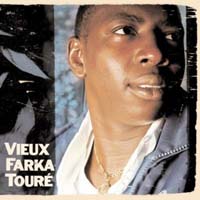
VIEUX FARKA TOURE
VIEUX FARKA TOURE (Modiba/World Village 468065)
Music history is littered with the offspring of famous people who tried to carve their own musical career. They may have a novelty appeal (like the Lennon or Marley kids) or even a hit (Nancy Sinatra) but for the most part we think, How sad, and their dad was so talented. Vieux Farka Toure is hamstrung by a name which suggests he is the elder here, but you get an an immediate sense that this is different. His album starts confidently in mid-stride and you know here is a serious contender for his late father's still-warm mantle. Though it is his debut album, there is a relaxed sense of accomplishment: the arrangements are full, the sidemen (some of whom backed his dad) well chosen, and there's the bittersweet element as Ali Farka makes a guest appearance as his swansong. Ali Farka, in fact, didn't want his son to be a musician, knowing full well the years of struggle and hardship that entails. This is traditional Malian music, mess less rooted in delta blues (as his father's was) with njarka (spike fiddle) and calabash percussion. The cathedral-like chimes of Ali's guitar float majestically into the opening of the third cut, "Tabara," with a sacramental tone, but Bassakou Kouyaté's ngoni ruptures the ascending cloud and brings us back to earth with some gutsy skirling. It's a mood more than a tune and drifts off aethereally to make way for a reggae groove that is unoriginal yet accomplished. (I've always been intrigued that African reggae seems stuck on Peter Tosh, not only as opposed to Marley, but as opposed to the musical evolution of reggae in the last two decades.) Mamadou Fofana is double-tracked on bass and that wild Peul flute on the next song, sung by Sekou Touré. Abruptly we gear down for a duet between Vieux and Toumani Diabaté, the virtuoso kora player, on a traditional piece about the last king of the Manding empire, Samory Touré. It's a beautifully done trancelike give-and-take & makes you eager for a whole album of the pair. But there's so much more to hear. Ali Farka pops back from beyond with his rocking "Baby please don't go" guitar lead on "Diallo." Again we are grounded in the savannah by the rocking ngoni contributed by Bassekou Kouyaté. Toumani Diabaté returns for another duet to close the album. All in all a superb production worthy all the superlatives being bandied about it.
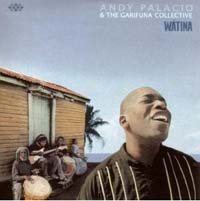
ANDY PALACIO & THE GARIFUNA COLLECTIVE
WATINA (Cumbancha CMB-CD-3)
There may be nothing to it, but when I first listened to Andy Palacio's new disc I heard an echo of the Tulsa sound made famous by J.J. Cale. Of course Cale was popularised by Eric Clapton and Mark Knopfler covers of his songs, but there's something to that clipped Ovation sound that carries over to Andy Palacio's new album. Palacio brought the Punta rock of Belize to the international stage a few years ago, but it owed as much to the techno synth-drenched rock posturing of zouk as to anything authentically homegrown, and he has now gone back to his roots. Garifuna Collective is a group of musicians exploring the traditional music of Belize that was on the verge of extinction. It's laid back and there's an echo of the burru drumming of Jamaica in the beat. The sound on this recording has a modernity to it, and a very accomplished production, so that makes it exactly the kind of thing that gets a lot of play on my system. It's also very different from other Caribbean music. The Garifuna are descendants of African slaves who were shipwrecked off St Vincent in 1635 and and blended into the indigenous Carib community, resisting European colonization (which led to their being exiled to the coast of Central America). Paul Nabor, legendary 75-year-old singer who joined Palacio on the great PARANDA album in 1989, returns for "Ayo da," a song which he wrote 60 years. The melodic simplicity is infused with musical virtuosity and a fine production by Ivan Duran.
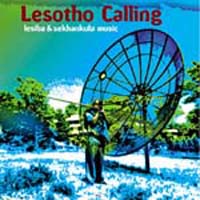
LESOTHO CALLING
LESIBA & SEKHANKULA MUSIC (Sharp Wood SWP 033)
When I first put this on I was taken aback -- I thought it was an Art Ensemble of Chicago album, then I remembered where those cats were coming from. This is real bush music, as in Burning Bush, Lick a Bush, Fermez la Bush, all of that. If you were in the bush in Lesotho and heard this instrument, the Lesiba, you might think it was a big insect getting ready to pounce. Lesotho is a kingdom in the highlands of South Africa. The intrepid Michael Baird went in the footsteps of Hugh Tracey to find out if anyone still played this instrument which is a woodwind with an unique organic sound, suggesting ancient culture. It is a metre long with a feather mouthpiece and a vibrating string, like a jew's harp, attached. The sound is buzzing, polyphonic, wonderful. The second instrument on here is the sekhankula which is a musical bow played by young boys who herd sheep. But it doesn't sound like any other African lyre: in fact it sometimes sounds like a brass instrument! The musicians compose topical songs about their lives. There's a squeezebox to round out the selection, but the lesiba is the striking sound on here. After editing and recreating the legacy of Hugh Tracey for us, Michael Beard has taken the logical step of continuing the legacy. HUGH TRACEY LIVES! This is a phenomenally good album. I imagine Steve Reich, Philip Glass and Kronos will be all over in a year or so, but before they spoil it and it turns trite and trendy on us, check out some pure African roots music.